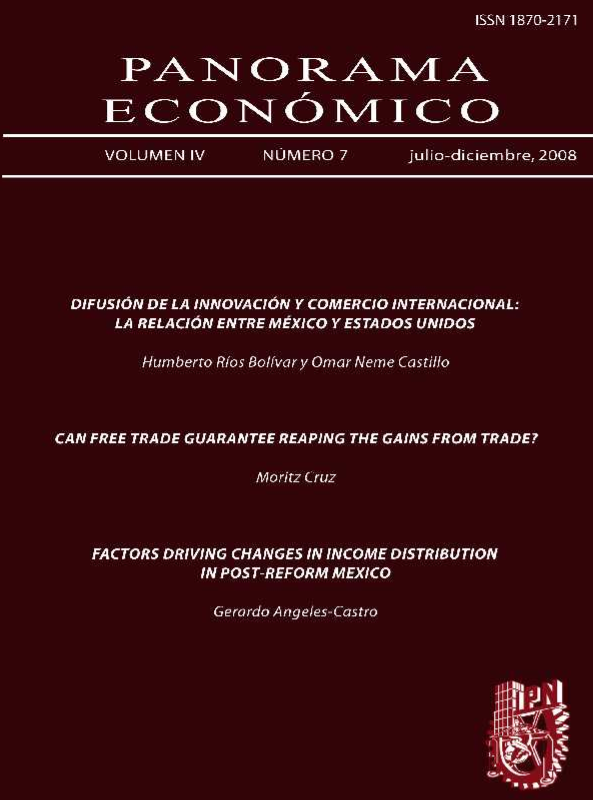Factors Driving Changes in Income Distribution in Post-Reform Mexico
Contenido principal del artículo
Después de 1984 y posterior a la liberalización económica, la desigualdad del ingreso en México se incrementó. Algunos de los principales factores que contribuyeron a esta tendencia son, el crecimiento relativo del ingreso promedio en el sector servicios, en relación con los sectores agrícola y manufacturero, lo cual es consistente con argumentos tales como la expansión de los servicios y la reducción de rentas en el sector comercial; el incremento en la tasa de retorno a la educación, que es consistente con la hipótesis del comercio como detonante de la demanda de la mano de obra calificada; y, la estabilización de la tasa de sindicalismo. Por otra parte, entre 1998 y 2002, la desigualdad disminuyó gradualmente. Algunos de los factores que propiciaron esta caída son, el decremento de la tasa de retorno a la educación, la caída de la tasa de retorno al sindicalismo y la estabilización de la tasa de sindicalismo. Esta tendencia es consistente con argumentos que sugieren efectos adversos temporales y ciclos en la evolución de la desigualdad del ingreso en el largo plazo. La recomposición de los hogares y los ingresos por transferencias son factores que mitigan la desigualdad, mientras que el deterioro del sector agrícola es una causa persistente de la dispersión del ingreso.
Acemoglu, Daron (2002), “Technical Change, Inequality and the Labour Market”, Journal of Economic Literature, 40(1), pp. 7-72.
Aghion, Philippe, Cecilia García-Pefalosa and Eve Caroli (1998), “Inequality and Economic Growth”, in: Philippe Aghion, and Jeffrey G.
Williamson (eds) Growth, Inequality and Globalization: Theory, History and Policy, (Cambridge: Cambridge University Press).
Airola, Jim and Juhn, Chinhui (2005), Wage Inequality in Post-Reform Mexico. Discussion paper series, No. 1525, IZA-Institute for the Study of Labour.
Arbache, Jorge S., Andy Dickerson, and Francis Green (2004), “Trade Liberalisation and Wages in Developing Countries”. The Economic Journal, 114, pp. 73-96.
Autor, David H., Lawrence F. Katz, and Alan B. Krueger (1998), “Computing Inequality: Have Computers Changed the Labour Market?”, Quarterly Journal of Economics, 113, pp. 1169-1213.
Baldwin, R. E. and G. G. Cain (2000), “Shifts in US Relative Wages: the Role of Trade, Technology, and Factor Endowments”. Review of Economics and Statistics, 82, pp. 580-595.
Bensusán, G (1999), “Integración Regional y Cambio Institucional: La Reforma Laboral en el Norte del Continente” in G. Bensusán, eds., Estandares laborales después del TLCAN, México D.F.; Friedrich Ebert Stiftung and Plaza y Valdes editores.
Berman, Eli, John Bound, and Stephen Machin (1998), “Implications of Skill Biased Technological Change: International Evidence”, Quarterly Journal of Economics, 113(4), pp. 1245-1279.
Corden, W. M. (1993), Protection and Liberalisation: a Review of the Analytical Issues. Occasional paper, No. 54, International Monetary Found.
Cortez, Willy W. (2001), “What is Behind Increasing Wage Inequality in Mexico?”, World Development, 29, pp. 1905-1922.
Feliciano, Zadia M. (2001), “Workers and trade liberalisation: the impact of trade reforms in Mexico on wages and employment”, Industrial and Labour Relations Review, 55, pp. 95-115.
Feenstra, R. C. and G. H. Hanson (1997), “Foreign Direct Investment and Relative Wages: Evidence from Mexico’s Maquiladoras”, Journal of International Economics, 42, pp. 371-394.
Fishlow, Albert and Karen Parker (1999), Growing Apart: The Causes and Consequences of Global Wage Inequality, (New York: Council on Foreign Relations Press).
FitzGerald, E. V. K. (1996), “The New Trade Regime: Macroeconomic Behaviour and Income Distribution in Latin America”, in: Victor Bulmer-Thomas (eds) The New Economic Model in Latin America and its Impact on Income Distribution and Poverty, (London: Macmillan Press LTD), pp. 29-52.
Flemming, J. S. and John Micklewright (2000), “Income distribution, Economic Systems and Transition”, in: Anthony B. Atkinson and Francois Bourguignon, (eds) Handbook of Income Distribution, Vol. 1, (Amsterdam: Elsevier), pp. 843-918.
Gordon, Jim, and Poonam Gupta (2003), “Understanding Indian Service Revolution”, Paper prepared for the IMF-NCAR conference, International Monetary Found, November 2003, http://www.imf.org/external/np/apd/seminars/2003/newdelhi/gordon.pdf.
Haskel, J. and M. J. Slaughter (2001), “Trade, Technology and UK wage Inequality”. Economic Journal, 111, pp. 163-187.
INEGI, Instituto Nacional de Estadística, Geografia e Informática (1985, 1990, 1995, 1999, 2003), ENIGH, Encuesta Nacional de Ingreso y Gasto de los Hogares, 1984, 1989, 1994, 1998, 2002, CD-Rom, México, DF.
Jacobsen, Peter W. F. and David E. A. Giles (1998), “Income Distribution in the United Sates: Kuznets’ Inverted-U Hypothesis and Data non-Stationary”, The Journal of International Trade & Economic Development, 7(4), pp. 405-423.
Jones, R. and J. Barry (1988), “Liberal Political Economy”, in: Jones, R. (eds) The Worlds of Political Economy, (London: Pinter Publishers), pp. 27-56.
Li, Hongyi, Lyn Squire, and Heng-Fu Zou (1998), “Explaining International and intertemporal Variations in Income Inequality”, The Economic Journal, 108, pp. 26-43.
Litwin, Carol (1998), Trade and Income Distribution in Developing Countries, Working papers in economics, No. 9, Department of Economics, Göteborg University.
Mah, Jai S. (2002), “The Impact of Globalization in Income Distribution: the Korean Experience”, Applied Economic Letters, 9, pp. 1007-9.
O’Connor, D. and M. R. Lunati (1999), Economic Opening and Demand for Skills in Developing Countries: A Review of Theory and Evidence, Technical Papers, No. 149, OECD Development Centre.
Robbins, Donald. J. (1996) “HOS Hits Facts: Facts Win; Evidence on Trade and Wages in the Developing World”, Discussion paper series, No. 557, Harvard Institute for International Development, Harvard University.
Ros, Jaime and César Bouillon (2002), “Mexico: Trade Liberalization, Growth, Inequality and Poverty”, in: Rob Vos, Lance Taylor and Ricardo Paes de Barros (eds) Economic Liberalization, Distribution and Poverty: Latin America in the 1990s, (Massachusetts: Edward Elgar Publishing, Inc.), pp. 347-389.
Singh, Ajit (2001), Income Inequality in Advanced Economies: A Critical Examination of the Trade and Technology Theories and an Alternative Perspective. Working Paper, No 219, ESRC Centre for Business Research, University of Cambridge.
Sinha, Aseema (2005), “Globalization, Rising Inequality and New Insecurities in India”, Paper presented at the conference on Difference on Inequality in Developing Societies, University of Virginia, April 2005, http://www.apsanet.org/imgtest/TaskForceDiffIneqDevSinha.pdf.
Smeeding, Timothy M. (2002), Globalisation, Inequality, and the Rich Countries of the G-20: Evidence from the Luxembourg Income Study (LIS). Working Paper, No 48, Syracuse University, Center for Policy Research.
Tanski, Janet M. and Dan W. French (2001), “Capital Concentration and Market Power in Mexico’s Manufacturing Industry: Has Trade Liberalization Made a Difference?”, Journal of Economic Issues, 35(3), pp. 675.
Yao, Shujie (1999), “On the Decomposition of Gini Coefficients by Population Class and Income Source: a Spread Sheet Approach and Application”, Applied Economics, 31, pp. 1249-1264.
Detalles del artículo

Esta obra está bajo una licencia internacional Creative Commons Atribución-NoComercial-SinDerivadas 4.0.







